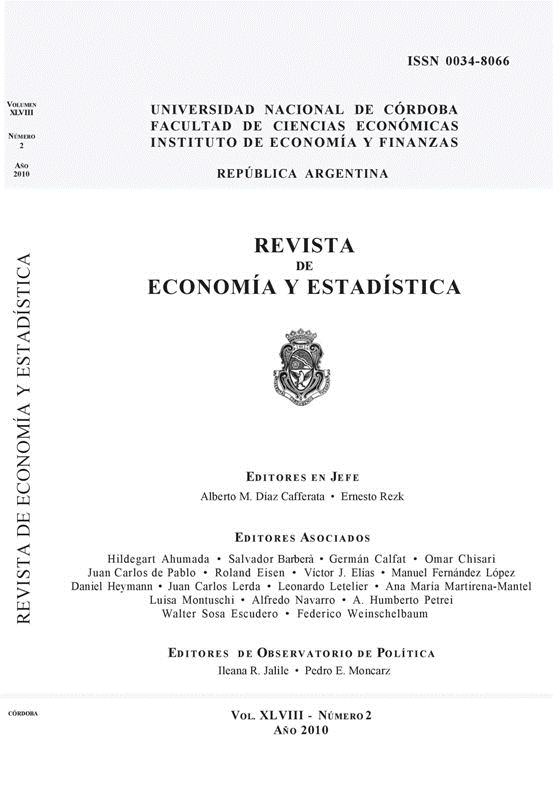Política fiscal y estabilidad macroeconómica: Nuevas evidencias e implicaciones de política
DOI:
https://doi.org/10.55444/2451.7321.2010.v48.n2.4107Palabras clave:
estabilización económica, política fiscal, estabilidad fiscalResumen
Este documento retoma el estudio de la relación empírica entre la políticafiscal y la estabilidad macroeconómica. Nuestro supuesto básico es que, pordefinición, el funcionamiento de los estabilizadores automáticas deberíasiempre y en todas partes contribuir a una mayor estabilidad macroeconómica(producción y consumo). Sin embargo, dos hechos estilizados parecen estar endesacuerdo con esa predicción. En primer lugar, el efecto moderador de losestabilizadores automáticos parece haberse debilitado en las economíasavanzadas entre los años 1990 y 2006. En segundo lugar, los estabilizadoresautomáticos no parecen ser eficaces en las economías en desarrollo. Nuestroanálisis aborda estos enigmas aparentes por medio del análisis del papelambivalente del gobierno como un amortiguador e inductor de shocks sobrelos determinantes de la volatilidad macroeconómica en el tiempo. Losresultados proporcionan un fuerte apoyo a la opinión de que la estabilizaciónfiscal opera principalmente a través de los estabilizadores automáticos.
Descargas
Referencias
Acemoglu, Daron, Simon Johnson, James Robinson, and Yunyong Thaicharoen (2002), “Institutional Causes, Macroeconomic Symptoms: Volatility, Crisis and Growth,” manuscript, MIT, Cambridge, MA.
Afonso, Antonio, Luca Agnello, and Davide Furceri (2009), “Fiscal policy responsiveness, persistence, and discretion,” Public Choice, forthcoming.
Alesina, Alberto (2000), “The political economy of the budget surplus in the US,” Journal of Economic Perspectives 14, 3-19.
Alesina, Alberto and Guido Tabellini (2005), “Why is fiscal policy often procyclical?” NBER Working Papers No 11600.
Andrés, Javier, Rafael Doménech, and Antonio Fatás (2008), “The stabilizing role of government size,” Journal of Economic Dynamics and Control 32, 571-93.
Baunsgaard, Thomas and Steven Symansky (2009), “Automatic fiscal stabilizers,” IMF Staff Position Note No 09/23.
Beck, Thorsten, George Clarke, Alberto Groff, Philip Keefer, and Patrick Walsh (2001), “New tools in comparative political economy: the database of political institutions,” World Bank Economic Review 15, 165-76.
Beetsma, Roel, Xavier Debrun, and Frank Klaassen (2001), “Is fiscal policy coordination in EMU desirable?” Swedish Economic Policy Review 8, 57-98.
Berger, Helge, and Ulrich Woitek (2005), “Does conservatism matter? A time-series approach to central bank behaviour”, The Economic Journal 115, 745-66.
Blanchard, Olivier (2000), “Commentary,” Economic Policy Review, April, (New York: Federal Reserve Bank of New York).
Blanchard, Olivier and Roberto Perotti (2002), “An empirical characterization of the dynamic effects of changes in government spending and taxes on output,” Quarterly Journal of Economics 117, 609-57.
Blinder, Alan, and Robert Solow (1974), “Analytical Foundations of Fiscal Policy,” in The Economics of Public Finance, (Washington, D.C: The Brookings Institution).
Botman, Dennis, Douglas Laxton, Dirk Muir, and Andrei Romanov (2006), “A new-open-economy macro model for fiscal policy evaluation,” IMF Working Paper No 06/45.
Bouthevillain, Carine, Philippine Cour-Thimann, Pablo Hernandez Cos, Matthias Mohr, Mika Tujula, Geert Langenus, Sandro Momigliano and Gerrit Van Den Dool (2001), “Cyclically-adjusted budget balances: an alternative approach,” ECB Working Papers No 77.
Catão Luis and Bennett Sutton (2002), “Sovereign defaults: the role of volatility,” IMF Working Paper No 02/149.
Crowe, Christopher and Ellen Meade (2008), “Central bank independence and transparency: evolution and effectiveness,” IMF Working Paper No 08/119.
Darby, Julia and Jacques Mélitz (2008), “Social spending and automatic stabilizers in the OECD,” Economic Policy 56, 715-56.
Debrun, Xavier, Jean Pisani-Ferry, and André Sapir (2008), “Should we forsake automatic stabilization?,” European Economy—Economic papers No 316.
Debrun, Xavier, David Hauner and Manmohan Kumar (2009), “Independent fiscal agencies,” Journal of Economic Surveys 23, 44-81.
Debrun, Xavier and Radhicka Kapoor (2010), “Fiscal policy and macroeconomic stability: automatic stabilizers work, always and everywhere,” IMF Working Paper No 10/111.
Dolls, Mathias, Clemens Fuest, and Andreas Peichl (2009), “Automatic stabilizers and economic crisis,” CESifo Working Paper No 2878.
Eichengreen, Barry, Ricardo Hausmann, and Juergen von Hagen (1999), “Reforming budgetary institutions in Latin America: the case for a national fiscal council,” Open Economies Review 10, 415–442.
Fatás, Antonio, and Mihov, Ilian (2001), “Government size and automatic stabilizers: international and intranational evidence,” Journal of International Economics 55, 3–28.
Fatás, Antonio, and Mihov, Ilian (2003), “The case for restricting fiscal policy discretion,” Quarterly Journal of Economics 118, 1419-47.
Fatás, Antonio, and Mihov, Ilian (2009), “The euro and fiscal policy,” NBER Working Paper No 14722.
Fedelino, Annalisa, Anna Ivanova and Mark Horton (2009), “Computing cyclically-adjusted balances and automatic stabilizers,” IMF Technical Notes and Manuals No 09/05.
Furceri, Davide (2009), “Stabilization effects of social spending: empirical evidence from a panel of OECD Countries,” North American Journal and Economics and Finance 21, 34-48.
Gavin Michael and Roberto Perotti (1997), “Fiscal policy in Latin America,” NBER Macroeconomics Annual 12, 11-72
Galì, Jordi (1994), “Government size and macroeconomic stability,” European Economic Review 38, 117–132.
Galì, Jordi, and Roberto Perotti (2003), “Fiscal policy and monetary integration in Europe,” Economic Policy 18, 533-72.
Girouard, Nathalie and Christophe André (2005), “Measuring cyclically-adjusted budget balances for OECD countries,” OECD Economics Department Working Paper No 434.
Henisz, Witold (2006), “The Political Constraint Index Dataset,” Wharton School of the University of Pennsylvania.
Horton, Mark, Manmohan Kumar, and Paolo Mauro (2009), “The state of public finances: a cross-country fiscal monitor,” IMF Staff Position Note No 09/21.
International Monetary Fund (2007), “The changing dynamics of the global business cycle,” Chapter 2 of the October World Economic Outlook, Washington, D.C..
Kumhof, Michael, and Douglas Laxton (2009), “Chile’s structural surplus rule: a model-based evaluation,” IMF Working Paper No 09/88.
Lee Young and Taeyoon Sung (2007), “Fiscal policy, business cycles and economic stabilization: evidence from industrialised and developing countries,” Fiscal Studies 28, 437-62.
Martinez-Mongay, Carlos, and Khalid Sekkat (2005), “Progressive taxation, macroeconomic stabilization and efficiency in Europe,” European Economy—Economic papers No 233.
Mohanty, M. S. and Fabrizio Zampolli (2009), “Government size and macroeconomic stability,” BIS Quarterly Review December, 55-68.
Perotti, Roberto (2005), “Estimating the effects of fiscal policy in OECD countries,” Proceedings, Federal Reserve Bank of San Francisco.
Persson, Torsten and Guido Tabellini (2000), Political Economics, The MIT Press, Cambridge, MA.
Rodrik, Dani (1998), “Why do more open economies have bigger governments?” Journal of Political Economy 106, 997–1032.
Romer, Christina, and David Romer (2008), “The macroeconomic effects of tax changes: estimates based on a new measure of fiscal shocks,” University of California, Berkeley, November (elsa.berkeley.edu/~cromer/draft1108.pdf).
Silgoner, Maria-Antoinette, Gerhard Reitschuler, and Jesus Crespo-Cuaresma (2003), “Assessing the smoothing impact of automatic stabilizers: evidence from Europe,” in Gertrude Tumpel-Gugerell and Peter Mooslechner (eds.), Structural Challenges for Europe, Edward Elgar.
Spilimbergo, Antonio, Steven Symansky, Olivier Blanchard, and Carlo Cottarelli (2008), “Fiscal policy for the crisis,” IMF Staff Position Note No 08/01.
Talvi, Ernesto and Carlos Vegh (2005), “Tax base variability and procyclical fiscal policy in developing countries,” Journal of Development Economics 78, 156-90.
Tornell, Aaron and Philip Lane (1999), “The voracity effect,” American Economic Review 89, 22-46.
van den Noord, Paul (2002), “Automatic stabilizers in the 1990s and beyond,” in Marco Buti, Jürgen von Hagen and Carlos Martinez-Mongay (eds.), The Behavior of Fiscal Authorities – Stabilization, Growth and Institutions, Basingstoke: Palgrave.
van der Ploeg, Rick (2005), “Back to Keynes?,” CESifo Economic Studies 51/4, 777-822.
Virén, Matti (2005), “Government size and output volatility: is there a relationship?” Bank of Finland Discussion Papers No 8.
Wyplosz, Charles (2006), “European monetary union: the dark sides of a major success,” Economic Policy 21, 207-61.
Descargas
Publicado
Número
Sección
Licencia
Derechos de autor 2010 Xavier Debrun, Radhicka Kapoor

Esta obra está bajo una licencia internacional Creative Commons Atribución-NoComercial-SinDerivadas 4.0.
Aquellos autores/as que tengan publicaciones con esta revista, aceptan los términos siguientes:
Los autores/as conservarán sus derechos de autor y garantizarán a la revista el derecho de primera publicación de su obra, el cuál estará simultáneamente sujeto a la Licencia Creative Commons Atribución-NoComercial-SinDerivar 4.0 Internacional que permite a terceros compartir la obra siempre que se indique su autor y su primera publicación esta revista.
Los autores/as podrán adoptar otros acuerdos de licencia no exclusiva de distribución de la versión de la obra publicada (p. ej.: depositarla en un archivo telemático institucional o publicarla en un volumen monográfico) siempre que se indique la publicación inicial en esta revista.
Se permite y recomienda a los autores/as difundir su obra a través de Internet (p. ej.: en archivos telemáticos institucionales o en su página web) antes y durante el proceso de envío, lo cual puede producir intercambios interesantes y aumentar las citas de la obra publicada. (Véase El efecto del acceso abierto)














